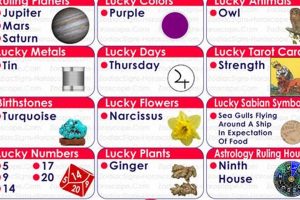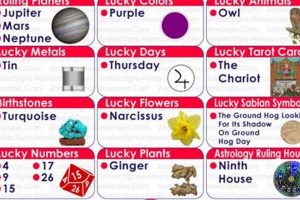The celestial configuration on this particular date each year holds significance for astrologers. It represents a snapshot of planetary positions, influencing interpretations of individual and collective experiences. For example, the Sun’s placement in a specific zodiac sign on this date, combined with the positions of other planets, contributes to the astrological profile of the day.
Understanding the astrological influences associated with this specific date can provide individuals with potential insights into prevailing energies and themes. This awareness might be used to navigate daily life with a heightened sense of purpose and understanding. Historically, astrologers have studied these celestial alignments to offer guidance and predictions. The practice is rooted in ancient traditions that seek to correlate celestial events with human affairs.
Further exploration of specific planetary placements, dominant astrological aspects, and their potential interpretations can offer a deeper understanding of the astrological significance of this date.
The period surrounding December 15th presents unique astrological influences. These tips offer potential strategies for navigating this time with awareness and intention.
Tip 1: Reflect on Personal Goals: The end of the year approaches. This period encourages reflection on accomplishments and the setting of intentions for the future. Consider journaling or meditation to clarify personal objectives.
Tip 2: Embrace Flexibility: Planetary alignments may present unexpected challenges or opportunities. Cultivating adaptability allows for smoother navigation of unforeseen circumstances.
Tip 3: Seek Balance: Energies during this period can be intense. Prioritizing self-care, including rest, healthy eating, and mindfulness practices, helps maintain equilibrium.
Tip 4: Connect with Nature: Spending time outdoors can provide grounding and rejuvenation. A walk in the park or observing the night sky offers a sense of connection to larger cycles.
Tip 5: Practice Active Listening: Communication can be nuanced. Careful attention to others’ perspectives fosters understanding and strengthens relationships.
Tip 6: Cultivate Patience: Not all endeavors will yield immediate results. Maintaining a patient approach allows for growth and development over time.
Tip 7: Express Gratitude: Focusing on positive aspects and expressing appreciation can shift perspectives and enhance overall well-being.
By integrating these practices, individuals may navigate the astrological influences of mid-December with greater clarity and purpose. These tips encourage a proactive approach to personal growth and development.
Further exploration of specific astrological transits and their interpretations can offer a deeper understanding of this period’s potential impact.
1. Sun's Position
The Sun’s position on December 15 holds significant weight in astrological interpretations. As the central celestial body in our solar system, its placement within a specific zodiac sign during this time imbues the day with distinct characteristics. Understanding the Sun’s influence provides a foundational layer for comprehending the broader astrological landscape of December 15.
- Zodiac Sign Influence
On December 15, the Sun resides in Sagittarius. This fire sign is associated with qualities such as optimism, expansion, and a thirst for knowledge. These traits color the general energetic themes prevalent on this date. For example, individuals may feel a stronger urge to explore new ideas, travel, or engage in philosophical pursuits. The Sagittarian influence encourages a broader perspective and a focus on higher learning.
- Degree within Sagittarius
The specific degree within Sagittarius occupied by the Sun on December 15 further refines the interpretation. Each degree carries subtle nuances that add depth to the astrological profile. For instance, if the Sun is at an early degree of Sagittarius, the energy might emphasize the initiation of new ventures. A later degree, on the other hand, could signify a culmination of previous experiences related to Sagittarian themes.
- Interaction with Other Planets
The Sun’s position interacts dynamically with other planetary placements on December 15. For example, a conjunction with Mercury might accentuate communication and mental acuity, while a square aspect with Mars could introduce a dynamic tension between assertive action and intellectual exploration. These planetary relationships create a complex interplay of energies that shape the overall astrological picture.
- Influence on Individual Birth Charts
The Sun’s placement on December 15 interacts uniquely with individual birth charts. If an individual has personal planets, such as the Moon or Ascendant, at a significant angle to the Sun on this date, it may amplify certain themes or present specific opportunities or challenges. Understanding these personalized interactions provides deeper insights into the potential impact of the Sun’s position on an individual level.
By considering these facets of the Sun’s position, a more nuanced understanding of its significance within the astrological context of December 15 emerges. This serves as a crucial starting point for further exploration of other planetary influences and their combined effect on this particular date.
2. Planetary Aspects
Planetary aspects on December 15 refer to the geometric angles between celestial bodies as viewed from Earth. These angular relationships are considered significant in astrology, influencing the energies and themes prevalent on this date. Analyzing these aspects provides deeper insight into the complex interplay of planetary influences.
- Conjunctions
A conjunction occurs when two or more planets occupy the same degree within the zodiac. This alignment intensifies the energies of the involved planets, creating a potent focus. For example, a conjunction between Venus and Mars on December 15 could amplify passion and creative drive. The specific signs involved further nuance the interpretation.
- Oppositions
An opposition occurs when planets are 180 degrees apart. This aspect creates a dynamic tension between opposing forces, highlighting polarities and requiring balance. An opposition between Saturn and Uranus, for instance, might manifest as a conflict between tradition and innovation or stability and change. Navigating this tension constructively becomes a central theme.
- Squares
Squares occur when planets are 90 degrees apart. This challenging aspect represents friction and necessitates effort to overcome obstacles. A square between Mercury and Neptune could lead to miscommunications or confusion. Developing clarity and discernment becomes crucial for effective navigation.
- Trines
Trines occur when planets are 120 degrees apart. This harmonious aspect facilitates ease of flow and supports growth and understanding. A trine between Jupiter and Pluto, for example, might present opportunities for expansion and transformation. Harnessing these supportive energies can lead to positive outcomes.
Understanding the interplay of these planetary aspects on December 15 provides a richer comprehension of the astrological influences at play. Analyzing these angular relationships in conjunction with the specific planets and signs involved offers valuable insights into the potential themes and energies characterizing this date.
3. Zodiacal Influences
Zodiacal influences play a crucial role in interpreting the astrological significance of December 15. The positions of the Sun, Moon, and planets within specific zodiac signs on this date contribute distinct energies and themes. Understanding these influences provides a framework for comprehending the broader astrological landscape.
- Sun’s Sign – Sagittarius
On December 15, the Sun typically resides in Sagittarius. This fire sign is associated with qualities such as optimism, expansion, and a pursuit of knowledge. The Sun’s placement in Sagittarius imbues the day with a focus on broader perspectives, philosophical inquiry, and a desire for exploration. This influence can manifest as increased enthusiasm for travel, learning, or engaging with different cultures.
- Moon’s Sign
The Moon’s sign on December 15 adds another layer of interpretation. The Moon represents emotional responses and inner experiences. For instance, if the Moon is in Pisces, a water sign, the day might carry a more sensitive and intuitive tone. If the Moon is in Aries, a fire sign, the emotional landscape could be more energetic and assertive. The Moon’s position interacts with the Sun’s placement, adding complexity to the overall astrological profile.
- Planetary Placements
The positions of other planets within specific zodiac signs on December 15 further refine the astrological interpretation. For example, if Mercury, the planet of communication, is in Capricorn, an earth sign, communication might be more practical and focused on tangible outcomes. If Venus, the planet of love and beauty, is in Scorpio, a water sign, relationships might take on a more intense and transformative quality. These planetary placements interact with each other and the Sun and Moon, creating a complex tapestry of influences.
- Interplay of Elements
The zodiac signs are grouped into four elements: fire, earth, air, and water. The distribution of planets among these elements on December 15 provides insights into the balance of energies. A predominance of fire signs might suggest a day characterized by enthusiasm and action, while a greater emphasis on earth signs could indicate a focus on practicality and material concerns. Understanding the interplay of these elemental influences offers a nuanced perspective on the overall astrological dynamic.
By considering these zodiacal influences, a deeper understanding of the astrological energies at play on December 15 emerges. This analysis provides a foundation for interpreting the potential themes and opportunities associated with this specific date, offering valuable insights into individual and collective experiences.
4. House Placements
House placements represent specific areas of life experience within an astrological chart. On December 15, the positions of planets within these houses offer personalized insights beyond the general zodiacal influences. The houses act as lenses through which planetary energies manifest in individual lives. For instance, if communicative Mercury occupies the fourth house, the focus might be on home and family communication on this date. Alternatively, if transformative Pluto resides in the tenth house, career matters could undergo significant shifts.
The interplay between planetary placements and house positions on December 15 adds depth to astrological interpretations. For example, expansive Jupiter in the second house might suggest financial opportunities. However, restrictive Saturn in the fifth house could present challenges in creative expression or romantic pursuits. Understanding these dynamics provides a nuanced perspective on how broader astrological influences interact with individual circumstances. Consider someone born with their Midheaven (the cusp of the tenth house) at 15 degrees Sagittarius. On December 15, the Sun will often conjunct their Midheaven, highlighting career and public image. This could manifest as recognition for their work or a pivotal moment in their professional trajectory. Conversely, someone with their Ascendant (the cusp of the first house) at 15 degrees Sagittarius might experience the Sun’s influence more personally, impacting their self-perception and how they present themselves to the world.
Analyzing house placements on December 15 provides a framework for understanding how astrological energies manifest in practical terms. By considering the specific planets and signs involved, individuals gain insights into potential areas of focus, challenge, or opportunity. This personalized approach allows for a deeper understanding of the astrological influences relevant to specific life domains.
5. Lunar Cycles
Lunar cycles, marked by the Moon’s continuous orbit around Earth, exert a subtle yet significant influence on astrological interpretations, including those pertaining to December 15. The Moon’s phase on this date contributes to the overall energetic landscape, adding another layer of complexity to planetary positions and aspects. Understanding the lunar context enhances the depth and nuance of astrological analysis.
- Moon Phase
The specific phase of the Moon on December 15whether new, full, waxing, or waningholds symbolic weight. A full moon amplifies emotions and highlights culmination, while a new moon signifies new beginnings and potential. A waxing moon suggests growth and building momentum, whereas a waning moon points towards release and introspection. The Moon’s phase interacts with other astrological factors on December 15, coloring the overall energetic tone.
- Moon Sign
The zodiac sign occupied by the Moon on December 15 adds further nuance. Each sign imbues the lunar influence with its distinct characteristics. For example, a Moon in fiery Aries might heighten impulsiveness and energy, while a Moon in watery Pisces could increase sensitivity and intuition. The Moon’s sign interacts with both the Sun’s position and other planetary placements, contributing to the complex interplay of energies.
- Lunar Aspects
The Moon forms aspects with other planets on December 15, creating dynamic relationships that shape the astrological landscape. A harmonious trine between the Moon and Venus might foster connection and emotional warmth, while a challenging square between the Moon and Mars could generate tension and irritability. These lunar aspects add another layer of complexity to the interpretation of planetary influences.
- Lunar Mansions
Some astrological traditions consider lunar mansions, which divide the Moon’s monthly cycle into 28 segments. Each mansion is associated with specific themes and energies. The mansion occupied by the Moon on December 15 can offer further insights into the prevailing lunar influences. This adds a layer of granularity to the astrological analysis, offering a more nuanced perspective on the Moon’s impact.
Integrating lunar cycle information into the astrological analysis of December 15 provides a richer, more comprehensive understanding of the energies at play. The Moon’s phase, sign, aspects, and mansion placement contribute unique nuances, interacting with other astrological factors to shape the overall energetic landscape of this particular date. Consideration of lunar cycles enhances the depth and precision of astrological interpretations.
6. Historical Transits
Examining historical transits occurring on or around December 15 provides valuable context for contemporary astrological interpretations. These past transits offer a glimpse into recurring patterns and potential themes associated with this specific date. By studying historical events coinciding with significant planetary alignments, astrologers can glean insights into the potential energetic influences at play. For example, a conjunction of Jupiter and Saturn on December 15 in a particular year might be analyzed alongside historical events that occurred during similar alignments in previous centuries. This comparative analysis could reveal recurring themes related to societal structures, economic shifts, or political developments. Additionally, examining historical transits involving outer planets like Uranus, Neptune, and Pluto, which have longer orbital periods, offers insight into broader generational influences. A significant transit of Neptune through a specific sign on December 15 in the past might correlate with historical trends related to spirituality, art, or social ideals. This understanding can inform present-day interpretations of Neptune’s influence. While historical transits provide valuable context, it’s essential to avoid deterministic interpretations. Astrology operates within a complex web of influences, and historical parallels serve as points of reference rather than predictors of specific outcomes. The practical significance of studying historical transits lies in the ability to recognize potential patterns and themes. This awareness can inform decision-making, promote greater understanding of current events, and offer insights into personal experiences.
Consider a hypothetical example: if Mars was at 15 degrees of Aries on December 15 in a particular year, and historical records show significant military conflicts or assertive political actions occurring during similar Mars transits, this information could be relevant for contemporary interpretations. It suggests a potential for heightened assertiveness or conflict during the current transit, but it does not predict specific events. The context provided by historical analysis allows for a nuanced understanding of the potential influences at play. Further, understanding the cyclical nature of planetary transits through historical analysis illuminates how astrological energies manifest over time. This perspective fosters a deeper appreciation for the interplay between individual actions and broader cosmic influences.
In summary, examining historical transits related to December 15 provides a valuable layer of context for astrological interpretations. By studying past patterns, recurring themes, and historical correlations, a deeper understanding of the potential energetic influences associated with this date emerges. This historical perspective enriches astrological analysis, providing a more nuanced and informative framework for navigating contemporary experiences. However, it’s crucial to maintain a balanced perspective, avoiding deterministic interpretations and recognizing the complex interplay of multiple astrological and societal factors. The value lies in the insights gained, which can inform decision-making and promote greater self-awareness.
7. Individual Birth Charts
Individual birth charts serve as personalized astrological blueprints, mapping the positions of celestial bodies at the precise moment of one’s birth. These unique configurations interact dynamically with the transiting planetary positions on any given date, including December 15. This interplay provides specific insights into how the general astrological influences of December 15 might manifest in individual experiences.
The positions of the Sun, Moon, and planets in an individual’s birth chart form specific angles, or aspects, to the transiting planets on December 15. These aspects can activate natal planetary energies, creating opportunities or challenges related to the areas of life represented by the natal houses involved. For example, if transiting Mars on December 15 forms a conjunction with someone’s natal Venus, it might stimulate romantic interactions or creative pursuits. Conversely, a square between transiting Saturn and someone’s natal Moon could evoke emotional introspection or challenges related to domestic matters.
Consider an individual born with Sun in Capricorn. The transiting Sun in Sagittarius on December 15 forms a challenging square aspect to their natal Sun. This could manifest as a need to balance personal ambitions with broader perspectives, potentially requiring adjustments to long-term goals. Another individual born with Moon in Pisces might experience heightened emotional sensitivity due to a trine from the transiting Moon in Scorpio on December 15. This could enhance intuitive abilities and facilitate deeper emotional connections.
Understanding the interplay between individual birth charts and the transiting planetary positions on December 15 allows for a nuanced interpretation of astrological influences. This personalized approach moves beyond generalized predictions and offers insights into potential areas of focus, growth, or challenge within specific life domains. While the general astrological themes of December 15 provide a backdrop, individual birth charts illuminate how these energies might manifest uniquely for each person. This understanding empowers individuals to navigate the astrological landscape with greater self-awareness and potentially leverage opportunities for personal growth.
Frequently Asked Questions about Astrological Influences in Mid-December
This section addresses common inquiries regarding the astrological significance of the period surrounding December 15th. The responses aim to provide clear and informative explanations.
Question 1: How does the specific date of December 15th hold astrological relevance?
The celestial configuration on each specific date reflects unique planetary positions, influencing astrological interpretations. December 15th’s astrological significance derives from the Sun’s placement in a particular degree of Sagittarius and its angular relationships with other planets. These positions offer insight into potential themes and energies prevalent during this period.
Question 2: Does the astrological significance of December 15th apply universally to everyone?
While general astrological influences associated with December 15th provide a broader context, individual experiences are further shaped by the specific configurations within personal birth charts. These unique natal charts interact with the transiting planetary positions, resulting in personalized expressions of the prevailing energies.
Question 3: How can one practically apply astrological insights related to December 15th?
Astrological insights can be utilized for self-reflection, identifying potential opportunities, and navigating challenges with greater awareness. Understanding the prevailing energies may inform decision-making, promote self-development, and facilitate a deeper understanding of personal experiences.
Question 4: Is it possible to predict specific events based on the astrology of December 15th?
Astrology does not offer deterministic predictions of specific events. Instead, it provides a framework for understanding potential influences and energies. Individual choices and external factors also play significant roles in shaping outcomes.
Question 5: What is the significance of planetary aspects on December 15th?
Planetary aspects, the geometric angles between celestial bodies, represent dynamic relationships that modify the expression of planetary energies. These aspectsconjunctions, oppositions, squares, and trinescontribute to the complexity of astrological interpretations, signifying potential harmony, tension, or amplification of specific influences.
Question 6: How do lunar cycles interact with the astrology of December 15th?
The Moon’s phase and sign on December 15th introduce additional nuances to the overall astrological landscape. The lunar cycle influences emotional undercurrents and adds a layer of complexity to the interpretation of planetary positions and aspects.
Understanding the astrological influences associated with December 15th provides a framework for navigating this period with greater awareness. However, individual interpretations and applications of these influences can vary.
Further exploration of specific astrological transits and their potential impact on individual birth charts offers a more personalized understanding of this period’s astrological significance.
Astrology December 15
Exploration of the astrological influences prevalent on December 15 necessitates a multifaceted approach. Analysis of planetary positions, aspects, zodiacal influences, house placements, and lunar cycles provides a comprehensive framework. Integrating historical transits adds valuable context, while consideration of individual birth charts allows for personalized interpretations. These factors contribute to a nuanced understanding of the potential themes and energies associated with this specific date.
The astrological significance of December 15 invites further investigation and reflection. Applying these insights may offer opportunities for self-awareness, personal growth, and navigating life’s complexities with greater understanding. Continued exploration of astrological principles and their practical applications remains a valuable pursuit for those seeking deeper meaning and connection to the cosmos.







